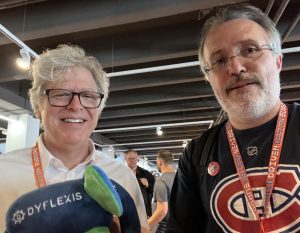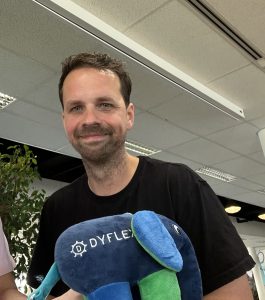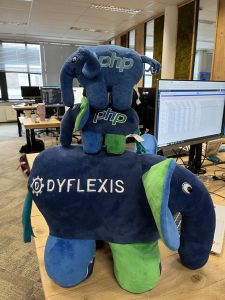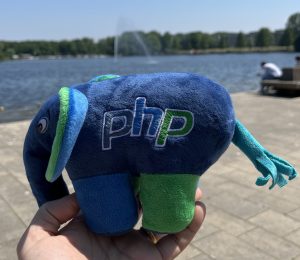 Lives of elePHPant: the story of Flexy
Lives of elePHPant: the story of Flexy
The title of ‘oldest elephpant’ is sticking with our beloved ‘Trisaieul’, the first elephpant, also known as the grand-father. The title of the youngest elephpant, on the other hand, changes as new generations of elephpants appear in the world: at one point of their life, every elephpant was the youngest elephpant. This is is the story of Flexy, the Dyflexis elephpant.
An elephpant for the tech department
The initial idea, was to make a PHP mascot for the Technology department of Dyflexis. Early 2023 was a wild period for the tech department, with many hires, new challenging projects and a lot of team growth. It was becoming increasingly important to foster a tech culture. That was well underway, and the idea of painting an elephpant to Dyflexis colors emerged. That’s how the story of flexy started.
Of course, having experience with delivering elephpant set me on a course to deliver a new generation. As usual, it was a wild ride, full of experiences and unexpected events. Always expect those from elephpants.
The value of the elephpant
The conception of any elePHPant generation starts with its value. The value is not the price of the elephpant, although that is a significant part of the success. The value is what the elephpant brings to the community: this has to be though both at large and locally.
A technology idol
The first value was the internal culture of technology. A lot of the work at Dyflexis is done with PHP: that felt natural. With a very collaborative atmosphere in the department, the teams with other dominant technologies were immediately onboard with the project. This is one of the formidable strengths of the elePHPant: it appeals to everyone, even well beyond the PHP community.

Elephpant for everyone
We used that strength to extend its reach to the rest of the company. Technology is not a key point when selling workforce management services: in fact, for that mission, the best technology is the one that works, and stays invisible. Just like the mythical ‘groundhog’ that Rasmus Lerdorf, the inventor of the language, likes to associate to PHP.
From the beginning, we envisionned to provide an elephpant for each employee in the company, tech or not. There are elephpants for past, present and even future employees. With the past employees, this is to keep good relationships, as they sail to new horizons; with future employees, it is a nice perk when getting hired, even if this should not be the main attracting point, obviously. As for the current employee, it is a good opportunity to explain the technology behind the company.
A token of gratitude
The second usage of the elephpant is to provide a token of gratitude to open source authors, whose code is part of everyday’s work. As with any modern company, a lot of the code is not written internally, but brought in as dependency. Shipping an elephpant to authors and their contributors is a way to tell them thank you, in an unusual way.
It also enhances the importance of gratitude. Our work usually depends on someone else’s contribution: it may come from past work, current colleagues or external authors.
And building the list of tools, authors and collaborators is a mission by itself. It means looking at one’s work, and spotting the important piece of software that one depends upon. That list is always longer than expected. Collecting all the dependencies make one realize how much we are standing on the shoulder of giants.

Classic marketing
Finally, the elephpant was identified as a classic marketing tool. It is a great and unusual gift to customers, providers and partners. It can be used with great effect at exhibitions and conferences.
With a bit of imagination, the elephpant can also use the ‘Amelie Poulain’ effect, from the movie of the same name. Amélie’s father is not courageous enough to go on travelling the world. So, Amélie hands her father’s garden dwarf to her airhostess friend, who then, brings it in various countries, and sends post cards to the bewildered father. In the end, the dwarf comes back in the garden, and the father takes on travelling.
The same scheme can be achieved with elephpant, through family pictures and traveling elephpants. Send it across the world, to customers and partners, who can share their local installation with a picture of two.
A new meaning to PHP
The international partners manager, Joris van Daalen, was very interested in using the elephpant for strengthening the network. Bearing the colors and logo of the company, as we’ll see in a moment, the elephpant is a great ambassador.
One anecdote that I will remember vividly for a long time, was the moment Joris discovered the PHP letters on the the left side of the elephpant, as is traditional. I saw disappointment running on his face.
After a brief moment, he gathered himself and shouted : “PHP! Partners Helping People!”. That was an impressive pivot, and also a lesser known meaning of the PHP acronym. And with that, the elephpant was becoming a even greater phenomenon.
Designing an elephpant
After making sure the elephpant found its value and spot in the company, the next step was to design it. For this, I teamed with Isley Martodihardjo for the design itself.
This was a very long and dynamic brainstorming session. You can imagine the the traditional opposition between the creative designer, pushing inventive ideas, and the engineer, denying many of them, dubbing them as not realistic when on the factory floor. The ideas went back and forth for an intense hour.
In the end, even the gradients, from green to blue, of the Dyflexis logo were set aside, and replaced with alternating colors. It gave a slight Frankenstein’s creature look to the elephpant, and yet, it is both very unusual and recognizable.
So much so that, when the prototype was displayed at the IPC Munich in Berlin, someone from the audience reached out to me, saying he recognized the Dutch company. Indeed, he was living in Amsterdam and heard about it recently.
Naming elephpants and the big book of haikus
Once the prototype was ready, the next phase is teasing the audience with it. Internally, that was the campaign for choosing a name. That is a critical moment for any elephpant, and the whole company was working on that task.
The naming was a two steps process : the first step is to collect suggestions from everyone. During that part, most of the names are weird and frankly quite strange. Yet, we collected over 50 suggestions, which were short-listed into a list of 6.
The second step was a vote on those 6 names, and we got ‘Flexy’ out of it. Nice choice!

Budgeting elephpants
After the design creation, comes the financial part. Based on the values that were set for the elephpant, we set up a budget of elephpant usage, as follows:
- 200 elephpants for employees
- 50 elephpants for past and future employees
- 50 elephpants for selling online
- 200 elephpants for gratitude
- 100 elephpants for marketing and partner network
- 100 elephpants for raffles
A first total of 700 elephpants was budgeted and discussed with the CFO of the company. As with any industrial process, the unit price of the plush toy tend to drop sharply at certain stages, and it is important to check if reaching the next level is interesting.
In this case, the next step was 900, and it made the extra elephpants 1 euros each. That meant another 200 elephpants for a very small budget increase. That was very tempting!
Moreover, 900 is the level where BIG elephpants could be done. Those are the really big ones, great for conferences and exhibition, as they really attract attention. They are also a lot of fun and a bit unusual to meet.
In the end, we agreed on a 900 batch, with 5 bigs ones. This is quite a nice generation of elephpants!
An elephpant for the whole company
Finally, as the day of the delivery of the elephpant approached, we set up the last teasing operation for the employees. Although there was a group of elephpants dedicated to every employee, it should not have been a simple present. We looked for a small challenge to pass to get that elephpant.
In the end, the challenge was to write a haiku. Haikus are a form of Japanese poetry, with strict rules and a short body of text. This is easy enough, and everyone can write it. The theme was elephpant, Flexy, Dyflexis and workforce management.
For those of us whow were not poetic or inspired enough, the solution was simple: make use of AI! And the easiest path is to ask someone in the tech department, since we all add our LLM account. Which is also the initial goal of the project: make tech department come forward.
What lays ahead of Flexy
In the end, more than 30 haikus were collected to celebrate the elephpant delivery when my mission terminated, by early November. In the short span of its life:
- Flexy managed to visit Eindhoven, Ibiza, Berlin and Canada;
- write a book of 30 haikus;
- generate 905 offsprings;
- break the record of elephpant tower (6 levels);
- thanks several Open Source projects
- put countless smiles on so many faces.
This is already such great achievements!
The future of the elephpant now lies with the Dyflexis tech department. If you are a OSS author or a previous employee, you can reach out to any of them and ask for an elephpant. This is the real value of the community mascot: building connexion between remote parts of the community and sharing stories. Once again, mission accomplished.

